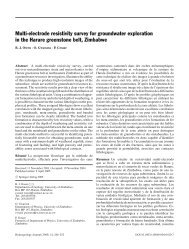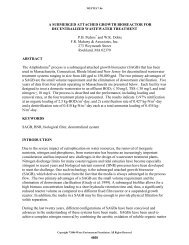Species diversity in the Florida Everglades, USA - Environmental ...
Species diversity in the Florida Everglades, USA - Environmental ...
Species diversity in the Florida Everglades, USA - Environmental ...
Create successful ePaper yourself
Turn your PDF publications into a flip-book with our unique Google optimized e-Paper software.
262 M. T. Brown et al. Ecosystem bio<strong>diversity</strong> <strong>in</strong> <strong>the</strong> <strong>Florida</strong> <strong>Everglades</strong><br />
exploit <strong>the</strong> concentrated food source that occurs dur<strong>in</strong>g<br />
<strong>the</strong> dry season. Less than half of <strong>the</strong> w<strong>in</strong>ter<strong>in</strong>g species<br />
stay <strong>in</strong> <strong>the</strong> <strong>Everglades</strong> year-round. O<strong>the</strong>rs are neotropical<br />
migrants that only stop temporarily before cross<strong>in</strong>g over<br />
<strong>the</strong> Gulf of Mexico to o<strong>the</strong>r regions <strong>in</strong> <strong>the</strong> Caribbean,<br />
Central and South America <strong>in</strong> <strong>the</strong> fall season, or while<br />
return<strong>in</strong>g to North America <strong>in</strong> <strong>the</strong> spr<strong>in</strong>g.<br />
The <strong>Everglades</strong> has historically served as a haven for<br />
wad<strong>in</strong>g birds (Ciconiiformes), with 16 residents found <strong>in</strong><br />
ENP. While wad<strong>in</strong>g birds are abundant <strong>in</strong> <strong>the</strong> region today,<br />
population numbers were signifi cantly higher 150<br />
years ago. Despite hav<strong>in</strong>g suffered enormous losses due<br />
to plume hunters at <strong>the</strong> end of <strong>the</strong> 19 th and early part of<br />
<strong>the</strong> 20 th century, <strong>the</strong> abundance of birds was still remarkable<br />
and <strong>in</strong> 1930 <strong>the</strong> number of wad<strong>in</strong>g birds nest<strong>in</strong>g <strong>in</strong><br />
<strong>the</strong> <strong>Everglades</strong> was estimated as 300,000 (McCally,<br />
1999). However, changes <strong>in</strong> <strong>the</strong> hydrologic regime stemm<strong>in</strong>g<br />
from <strong>the</strong> Central and South <strong>Florida</strong> Project of 1949,<br />
which created compartmentalization of water fl ows that<br />
is presently be<strong>in</strong>g restored, have and cont<strong>in</strong>ue to reduce<br />
wad<strong>in</strong>g birds populations. By <strong>the</strong> early 1990s, only<br />
10,000–50,000 wad<strong>in</strong>g birds were estimated to nest <strong>in</strong><br />
<strong>the</strong> <strong>Everglades</strong> (Ogden, 1997).<br />
Due to alteration of <strong>the</strong> water fl ows and result<strong>in</strong>g<br />
shifts <strong>in</strong> plant community, two habitat specifi c residents<br />
of <strong>the</strong> <strong>Everglades</strong> are now endangered. The endemic<br />
Cape Sable seaside sparrow (Ammodramus maritima)<br />
breeds only <strong>in</strong> marl prairies covered with select marsh<br />
grasses (Muhlenbergia spp. or sparse Cladium jamaicense)<br />
(Nott and Comiskey, n.d.). The snail kite (Rostrhamus<br />
sociabilis plumbeus), a resident of subtropical<br />
Table 6. Families and species counts for reptiles and amphibians of<br />
<strong>the</strong> <strong>Everglades</strong>.<br />
Reptile Families Count Amphibian Families Count<br />
Alligatoridae 2 Ambystomatidae 3<br />
Anguidae 3 Amphiumidae 2<br />
Cheloniidae 1 Bufonidae 3<br />
Chelydridae 1 Hylidae 10<br />
Colubridae 17 Leptodactylidae 2<br />
Crocodylidae 1 Microhylidae 1<br />
Emydidae 5 Plethodontidae 8<br />
Gekkonidae 5 Proteidae 1<br />
Iguanidae 2 Ranidae 6<br />
K<strong>in</strong>osternidae 1 Salamandridae 1<br />
Phrynosomatidae 2 Sirenidae 1<br />
Polychridae 5<br />
Rh<strong>in</strong>euridae 1<br />
Sc<strong>in</strong>cidae 6<br />
Teiidae 2<br />
Testud<strong>in</strong>idae 1<br />
Trionychidae 1<br />
Tropiduridae 2<br />
Viperidae 2<br />
Table 5. <strong>Species</strong> (n = 431) <strong>in</strong> each of 90 fi sh families <strong>in</strong> <strong>the</strong> <strong>Everglades</strong>. Numbers <strong>in</strong> paren<strong>the</strong>ses <strong>in</strong>dicate <strong>the</strong> number of species (n = 256) <strong>in</strong><br />
each family for which <strong>the</strong> record <strong>in</strong> <strong>the</strong> region is considered reliable.<br />
Family <strong>Species</strong> Family <strong>Species</strong> Family <strong>Species</strong><br />
Cypr<strong>in</strong>idae 32 ( 8) Sparidae 5 (5) Sphyraenidae 2 (2)<br />
Centrarchidae 24 ( 3) Belonidae 4 (1) Stromateidae 2 (2)<br />
Sciaenidae 18 (18) Centropomidae 4 (3) Synodontidae 2 (1)<br />
Percidae 17 ( 7) Cichlidae 4 (4) Albulidae 1 (1)<br />
Clupeidae 16 ( 4) Lepisosteidae 4 (1) Amiidae 1 (0)<br />
Cypr<strong>in</strong>odontidae 16 ( 1) Ophidiidae 4 (3) Anguillidae 1 (0)<br />
Gobiidae 16 (15) Scombridae 4 (4) Antennariidae 1 (1)<br />
Carangidae 14 (13) Batrachoididae 3 (0) Aphredoderidae 1 (0)<br />
Syngnathidae 13 ( 7) Dasyatidae 3 (2) Aplocheilidae 1 (1)<br />
Serranidae 12 ( 9) Echeneidae 3 (1) Callionymidae 1 (1)<br />
Bothidae 11 (11) Eleotridae 3 (1) Chaetodontidae 1 (1)<br />
Ictaluridae 10 ( 2) Labridae 3 (3) Clariidae 1 (0)<br />
Poeciliidae 9 ( 1) Sphyrnidae 3 (2) Coryphaenidae 1 (1)<br />
Scaridae 9 ( 9) Triglidae 3 (3) Ephippidae 1 (1)<br />
A<strong>the</strong>r<strong>in</strong>idae 8 ( 4) Acipenseridae 2 (1) Gobiesocidae 1 (0)<br />
Haemulidae 8 ( 8) Apogonidae 2 (2) Lobotidae 1 (1)<br />
Balistidae 7 ( 7) Ariidae 2 (0) Loricariidae 1 (0)<br />
Catostomidae 7 ( 1) Bythitidae 2 (2) Mobulidae 1 (1)<br />
Blenniidae 6 ( 6) Elopidae 2 (0) Molidae 1 (1)<br />
Carcharh<strong>in</strong>idae 6 ( 3) Esocidae 2 (0) Polynemidae 1 (1)<br />
Characidae 6 ( 0) Lamnidae 2 (2) Pomatomidae 1 (1)<br />
Engraulidae 6 ( 1) Muraenidae 2 (2) Priacanthidae 1 (1)<br />
Exocoetidae 6 ( 4) Myliobatidae 2 (1) Pristidae 1 (1)<br />
Gerreidae 6 ( 6) Ogcocephalidae 2 (1) Rachycentridae 1 (1)<br />
Lutjanidae 6 ( 6) Ostraciidae 2 (2) Rajidae 1 (1)<br />
Ophichthidae 6 ( 5) Percichthyidae 2 (0) Rh<strong>in</strong>obatidae 1 (1)<br />
Tetraodontidae 6 ( 6) Petromyzontidae 2 (0) Torped<strong>in</strong>idae 1 (1)<br />
Cl<strong>in</strong>idae 5 ( 5) Pomacentridae 2 (2) Trichiuridae 1 (1)<br />
Mugilidae 5 ( 4) Rh<strong>in</strong>codontidae 2 (2) Umbridae 1 (1)<br />
Soleidae 5 ( 4) Scorpaenidae 2 (2) Xiphiidae 1 (1)
















